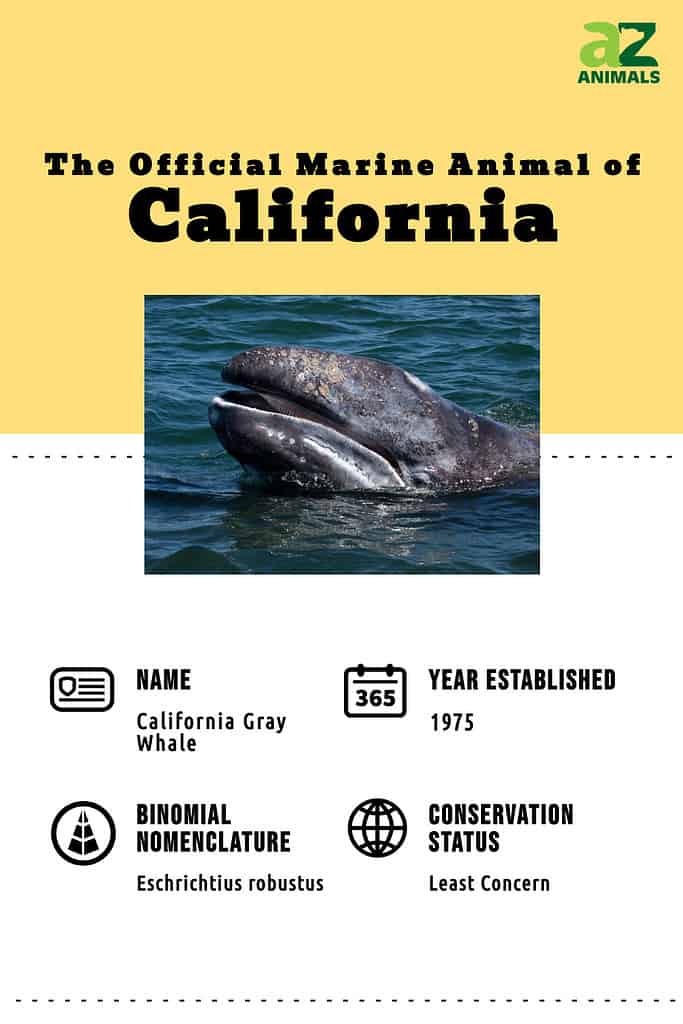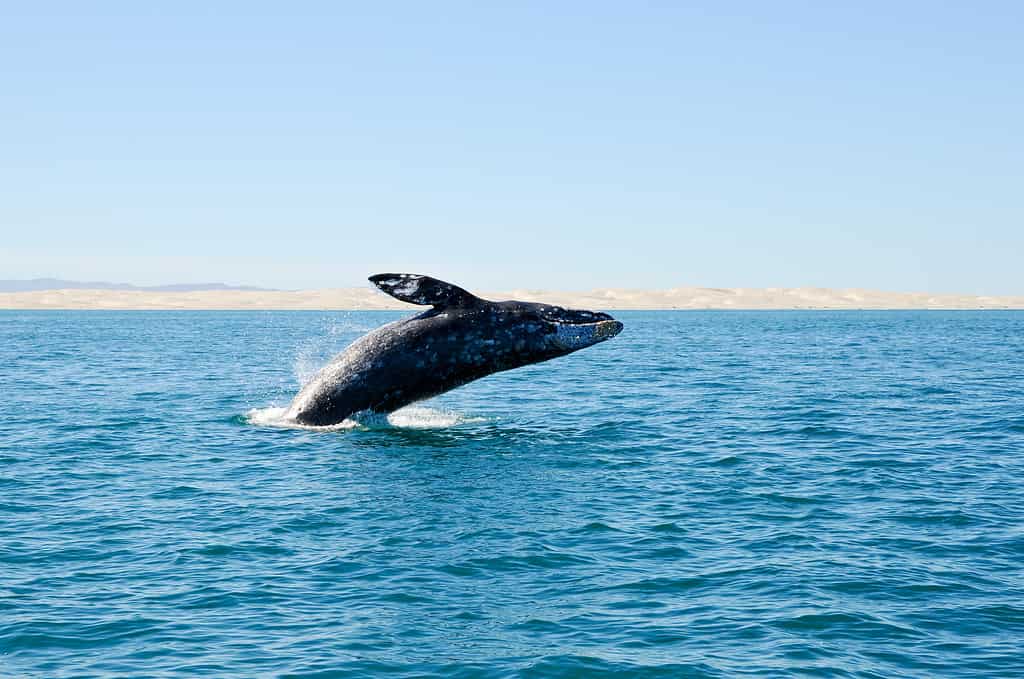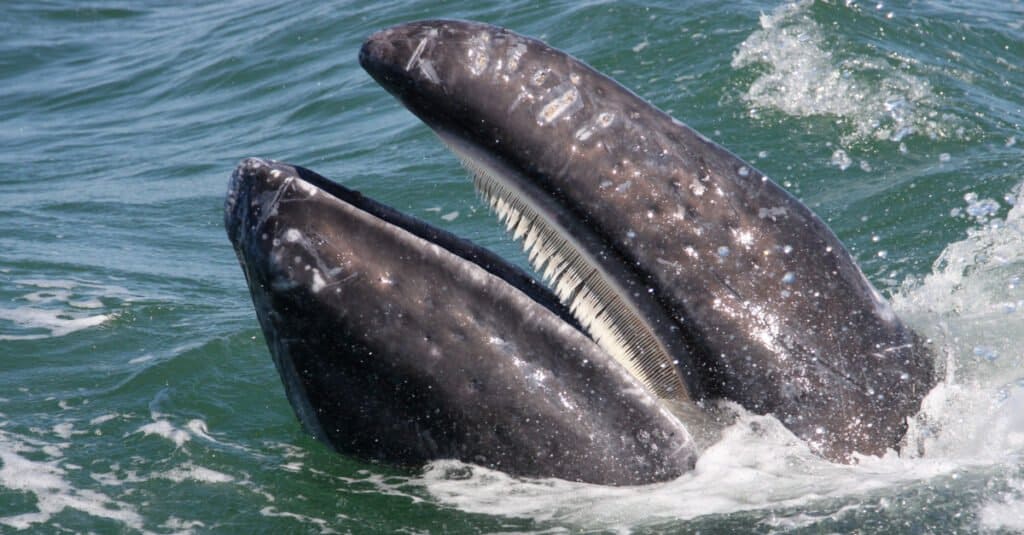The Golden State has a wide range of official symbols, from its official amphibian, the red-legged frog, to its state tree, the California redwood. The largest animal representing California, however, is none other than its state marine mammal: the majestic gray whale. As the only living species within its taxonomic family’s sole genus, this unique animal was threatened by whaling in the 1800s but has managed to return to its former glory in more recent years. Keep reading to learn more about this incredible symbol of California and its vast coastal waters, including its size, habitat, diet, and where you might even be able to spot them!

California’s Official Marine Mammal: The California Gray Whale
While most of California’s residents are aware of their home state’s official animal, the grizzly bear, the state’s official marine mammal isn’t quite as widely known or understood. The California gray whale goes by a few common names, including the gray back whale and the Pacific gray whale. As a baleen whale, its mouth is full of lots of long, thin baleen plates. It uses these plates to filter feed on small, aquatic arthropods. Its primary food group consists of amphipods, or tiny, soft-bodied crustaceans that somewhat resemble shrimp.
As its common name implies, the gray whale’s massive body is a dark, cool gray color. Most individuals are covered in lots of small, white splotches that increase in number with age. These spots are scars often left behind by small, aquatic parasites. The parasites feed on the whale’s body, eventually falling off at the end of their life cycle. Like most baleen whales, gray whales also have two blowholes atop their heads, as opposed to toothed whales, which just have one.

California’s official marine mammal is the California gray whale.
©Mogens Trolle/Shutterstock.com
Another distinctive feature of the gray whale is its lack of a dorsal fin. Instead, it has around 6 to 12 raised bumps, or “knuckles” along its back, forming a dorsal ridge. This gives the whale its characteristically bumpy, textured skin. These ridges lead down to its massive, forked tail, which can reach up to 11 feet in width!
One of the gray whale’s most incredible traits is its ability to travel long distances. The average gray whale travels 14,000 miles a year during its annual migration. During the warmer months of the year, they spend most of their time in the Bering Sea. When things cool down, though, most gray whales travel south to California’s coasts. Here, they meet with one another in groups to mate and reproduce.
How Big Are Gray Whales?

Newborn gray whales at birth already weigh a staggering 2,000 pounds.
©Travis Potter/Shutterstock.com
Out of all known whale species, the California gray whale is the seventh largest. It is the ninth-largest cetacean species overall. Even newborn gray whales are around 15 feet long. Upon reaching their full size, they can measure up to 50 feet in length. While there are a handful of whale species that exceed this length, the gray whale’s body is very heavy for its size.
At birth, a newborn gray whale already weighs in at around 2,000 pounds! They reach sexual maturity at 6 to 12 years of age. Most individuals hit their full adult size at around 10 years old. A fully mature gray whale can range from 60,000 to 90,000 pounds.
As a sexually dimorphic species, females are slightly larger than males. This is because female gray whales must have larger bodies to accommodate their enormous one-ton babies, better known as calves. They also have to supply their babies with milk, often even during their yearly migrations. This all means they must expend more energy than males and therefore have evolved to be a bit heavier by comparison.
How Many Gray Whales Are There in the Wild?

While NOAA estimated about 27,000 gray whales in the world in 2016, that number has fluctuated greatly, and even declined, since.
©Jan-Dirk Hansen/Shutterstock.com
The California gray whale has had a harrowing journey over the years when it comes to its overall numbers and population size. It’s worth noting that several distinct populations of gray whales have existed over the years. Two main groups have been consistently recorded: its North Pacific and North Atlantic populations.
Thankfully, the gray whale’s numbers are much healthier today. However, things were very dire for the species in the 17th to 20th centuries, when whaling decimated much of its North Atlantic and Pacific populations. Conservation efforts and strict population management have helped revive the species and stabilize its populations, especially after the US outlawed whaling entirely in 1971.
In more recent years, the National Oceanic and Atmospheric Administration (NOAA) has closely monitored the species’ North Pacific numbers. Notably, the California gray whale’s North Pacific population is further divided into two parts: one very small group in the western North Pacific Ocean near the Sea of Okhotsk, and its main, much larger, eastern North Pacific group off of California’s coasts.
In 2016, the NOAA estimated the eastern North Pacific population to be around 27,000 individuals. As of 2022, though, its numbers have declined once more to around 16,000. The western North Pacific portion suffered a major hit in the 2000s and 2010s. Luckily, it has been increasing once more as of 2018, with its conservation status changing from critically endangered to endangered.
Currently, most experts believe the species’ North Atlantic population has gone extinct. Interestingly, though, some sporadic, unconfirmed sightings have been reported as recently as 2021.
Where and When Can You See Gray Whales in California?

The North Atlantic population begins its annual migration to California’s coasts in January.
©jo Crebbin/Shutterstock.com
If you’re hoping to see the majestic California gray whale in action, the best time of year to look for them is January through March. This is when the eastern North Atlantic population goes on its yearly migration and travels from the Bering Sea down to California’s coasts, particularly its southern half toward Mexico’s Baja California. This is also when gray whales congregate to socialize, mate, and reproduce, so you’re more likely to see them in groups during this time. If you’re really lucky, you might even spot gray whale calves traveling alongside their mothers!
There are many excellent locations for viewing gray whales along California’s coasts during the cooler months of the year. One of the most popular is none other than Monterey Bay, located right between the state’s northern and southern halves along its coastline. If you live or are visiting closer to northern California, Mendocino County is a prime spot. The Mendocino Headlands State Park provides plenty of great whale-watching spots along its coastal trails.
If you’re able to head down to southern California, though, you’ll find some of the state’s best areas for observing these incredible marine mammals. Just outside of San Diego lies La Jolla, where guided whale-watching tours are common during late winter and early spring. Los Angeles’ popular Laguna Beach also boasts a Marine Protected Area Reserve. Here, you’re especially likely to see gray whales on their yearly migration.
The photo featured at the top of this post is © Travis Potter/Shutterstock.com
Thank you for reading! Have some feedback for us? Contact the AZ Animals editorial team.






